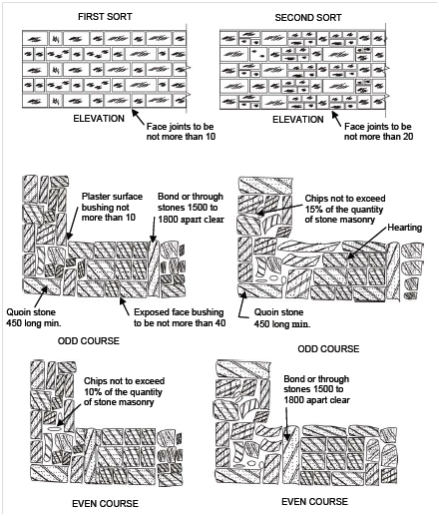Coursed Rubble Masonry
Ist Sort
The face stones should be hammer dressed on all sides to provide them approximately rectangular shape. These should be squared on all joints and beds.
The bed joints are rough chisel dressed to a depth of at least 8 cms from the face and the side joints for at least 4 cms such in which no portion of the dressed surface is more than 6 mm from a straight edge placed on it. The projections (or bushings) on the face stone should not be more than 4 cms beyond the side or bed joint. The courses shall be laid as alternate stretchers and headers in horizontal layers and the side joints shall be vertical. The height of every course is generally among 15 cm to 30 cm. No face stone should be less in breadth than its height and at least one third of them shall tail within the hearting to a length equivalent to twice their height. The hearting or the interior shall also consist of stones carefully laid on their beds. Chips could be used to fill the interstices but the quantity used should not exceed 10 percent of the stone masonry. Bond stones shall be given in every course, the spacing being 1.5 to 1.8 m. The quoins shall be of the similar height as the course and at least 45 cm long, laid as stretchers and headers. The beds of these stones shall be chisel dressed to a depth of 10 cm. commonly; quoins have a chisel draft 2.5 cm huge along the edges of the face. The face joints within the masonry shall not be more than 1 cm thick.

Figure : Coursed Rubble Masonry (All Dimensions are in mm)
2nd Sort
This is same to the work discussed previously, except in which the dressing of the joints could be rougher, along with the deviation being 10 mm from a straight edge and the use of chips within the hearting could be 15 percent. Some of the stones in every course could be of half height so in which two stones are used to make up the course. The face joints could be 2 cm thick.